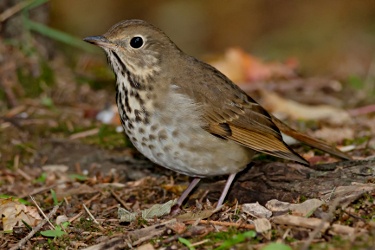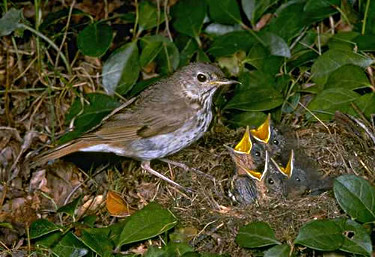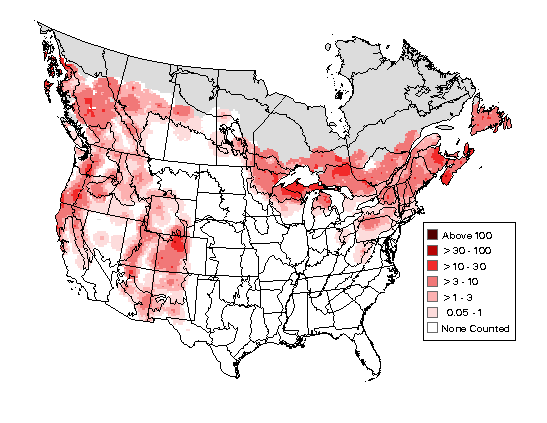Hermit Thrush

Hermit Thrush Information
Length: 6.5 - 7.5"
Habitat: Nests in dense coniferous or mixed woodlands and their edges; edges of interior forest clearings such as ponds, logging roads, and utility cuts.
Diet: During breeding season: insects and their larvae; spiders; other invertebrates, including earthworms and snails; small salamanders.
In fall and winter: fruits and berries.
![]() Song and calls of the Hermit Thrush
Song and calls of the Hermit Thrush![]()
Additional Information
Hermit ThrushHabitat, diet, feeding behavior, nesting, migration, and conservation status of this bird. Includes range map, photos, and songs and calls. (From Audubon Field Guide)
Hermit Thrush at Nest

© NNE & licensors
Hermit Thrush
Identification Tips
- Birds in eastern United States have olive-brown upperparts; gray-brown in western birds
- White eye ring
- Dark spots on breast
- Underparts white with brownish to grayish flanks
- Pink legs
- Thin bill with pale base to lower mandible
- Sexes similar
- Often forages on forest floor
- Distinctive song
- Only brown-backed thrush to regularly winter in the United States
- Migrates earlier in Spring and later in Fall than similar-looking thrushes
The Hermit Thrush resides in forests where it is more often heard than seen. It is most similar to other thrushes but can be told from them by its rusty rump and tail contrasting with the duller back and wings
(Credit: U. S. Geological Survey)
Breeding Bird Survey Map,
2011-2015

(Image credit: USGS)
Range in New England
The Hermit Thrush breeds throughout New England.
This songbird can be found year round, although in low numbers, in eastern Massachusetts, southern Connecticut as well as the Connecticut River Valley, southern Rhode Island, and along the coast of New Hampshire and southern Maine.
Winter Map from eBird
Sightings of the Hermit Thrush from
Jan-Mar over past 10 years
(2009-2019)![]()
Christmas Bird Count Map
Historical CBC Map from USGS